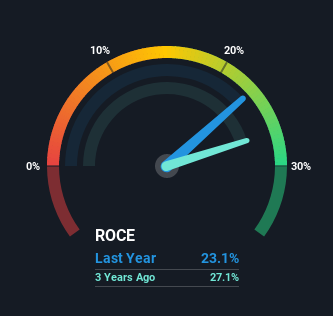- Hong Kong
- /
- Construction
- /
- SEHK:8423
Chi Ho Development Holdings' (HKG:8423) Returns On Capital Not Reflecting Well On The Business

Did you know there are some financial metrics that can provide clues of a potential multi-bagger? In a perfect world, we'd like to see a company investing more capital into its business and ideally the returns earned from that capital are also increasing. This shows us that it's a compounding machine, able to continually reinvest its earnings back into the business and generate higher returns. So while Chi Ho Development Holdings (HKG:8423) has a high ROCE right now, lets see what we can decipher from how returns are changing.
Understanding Return On Capital Employed (ROCE)
Just to clarify if you're unsure, ROCE is a metric for evaluating how much pre-tax income (in percentage terms) a company earns on the capital invested in its business. The formula for this calculation on Chi Ho Development Holdings is:
Return on Capital Employed = Earnings Before Interest and Tax (EBIT) ÷ (Total Assets - Current Liabilities)
0.23 = HK$31m ÷ (HK$263m - HK$130m) (Based on the trailing twelve months to September 2021).
So, Chi Ho Development Holdings has an ROCE of 23%. In absolute terms that's a great return and it's even better than the Construction industry average of 8.7%.
View our latest analysis for Chi Ho Development Holdings

Historical performance is a great place to start when researching a stock so above you can see the gauge for Chi Ho Development Holdings' ROCE against it's prior returns. If you'd like to look at how Chi Ho Development Holdings has performed in the past in other metrics, you can view this free graph of past earnings, revenue and cash flow.
What Can We Tell From Chi Ho Development Holdings' ROCE Trend?
In terms of Chi Ho Development Holdings' historical ROCE movements, the trend isn't fantastic. While it's comforting that the ROCE is high, five years ago it was 56%. Given the business is employing more capital while revenue has slipped, this is a bit concerning. If this were to continue, you might be looking at a company that is trying to reinvest for growth but is actually losing market share since sales haven't increased.
On a related note, Chi Ho Development Holdings has decreased its current liabilities to 49% of total assets. So we could link some of this to the decrease in ROCE. What's more, this can reduce some aspects of risk to the business because now the company's suppliers or short-term creditors are funding less of its operations. Since the business is basically funding more of its operations with it's own money, you could argue this has made the business less efficient at generating ROCE. Either way, they're still at a pretty high level, so we'd like to see them fall further if possible.
In Conclusion...
In summary, we're somewhat concerned by Chi Ho Development Holdings' diminishing returns on increasing amounts of capital. This could explain why the stock has sunk a total of 93% in the last three years. With underlying trends that aren't great in these areas, we'd consider looking elsewhere.
One final note, you should learn about the 3 warning signs we've spotted with Chi Ho Development Holdings (including 1 which is a bit unpleasant) .
High returns are a key ingredient to strong performance, so check out our free list ofstocks earning high returns on equity with solid balance sheets.
New: AI Stock Screener & Alerts
Our new AI Stock Screener scans the market every day to uncover opportunities.
• Dividend Powerhouses (3%+ Yield)
• Undervalued Small Caps with Insider Buying
• High growth Tech and AI Companies
Or build your own from over 50 metrics.
Have feedback on this article? Concerned about the content? Get in touch with us directly. Alternatively, email editorial-team (at) simplywallst.com.
This article by Simply Wall St is general in nature. We provide commentary based on historical data and analyst forecasts only using an unbiased methodology and our articles are not intended to be financial advice. It does not constitute a recommendation to buy or sell any stock, and does not take account of your objectives, or your financial situation. We aim to bring you long-term focused analysis driven by fundamental data. Note that our analysis may not factor in the latest price-sensitive company announcements or qualitative material. Simply Wall St has no position in any stocks mentioned.
About SEHK:8423
Chi Ho Development Holdings
An investment holding company, provides building renovation and construction services in Hong Kong.
Excellent balance sheet and good value.
Market Insights
Community Narratives



